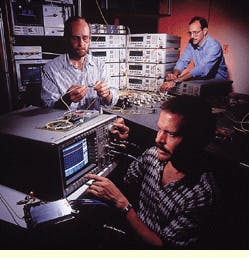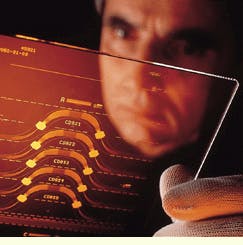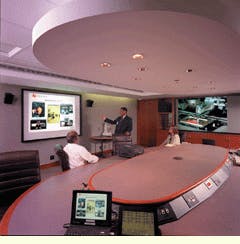Optoelectronic technology promises higher bandwidth, faster transmission speed, and other benefits for the networks of the future.
Eric J. Lerner, Laser Focus World
For the first nearly 30 years after the invention of the transistor, information processing and transmission meant electronics that used semiconductors to control the flow of electrons. But beginning in the early 1980s, electronics were increasingly supplemented by optics, and photons took their place alongside electrons as the carriers of information.
Today, optoelectronic devices--those that couple electronics and optics--have grown to dominate much of long-distance communications through fiber optics, have given rise to new methods of displaying information and of sensing it in the environment, and are beginning to penetrate into the heart of information processing, as information communication and processing become more and more intimately linked in integrated optoelectronic circuits. Indeed, the optoelectronic devices of the present may prove to be merely a transition to all-photonic computation and communication of the future.
To fully understand this technology, it`s important to look briefly at two basic questions: Why has optoelectronics become so important and why does it continue to grow? The primary answer is simple--speed. There are fundamental physical limits to how fast information can be transmitted purely electronically. As the frequency of an electromagnetic signal increases, the ability to propagate it through an electrical conductor declines. The signal is restricted to a smaller and smaller "skin depth," making electrical resistance higher and higher. Except for very short distances, signals at frequencies much above 100 megahertz must be carried by coaxial cables, and, in such a case, the diameter must grow as the frequency increases to compensate for the shrinking skin depth.
In practice, guided signals cannot be sent along coaxial cables at rates greater than 1 gigahertz. For unguided transmissions, such as those used by communications satellites, much higher microwave frequencies, up to tens of gigahertz, are possible.
In contrast, optical signals propagate through transparent, nonconducting media and operate in the visible and near- infrared (IR) wavelengths. These correspond to frequencies of approximately 200 terahertz, thousands of times higher than are possible using purely electronic means. Furthermore, the relatively short wavelengths of IR and visible light--about 1 micron--mean that optical components with their gigantic speed can be miniaturized right down to the component size of contemporary microelectronics. In addition, the use of optical technology together with electronics adds a new layer of flexibility of design, producing new approaches for sensing and display. For all these reasons optoelectronics has become and remains one of the fastest growing aspects of information processing and transfer.
Fiber-optic communications systems
Fiber-optic telecommunications is without doubt the largest segment of the optoelectronics market, yet it is also the most invisible to the average consumer. After all, fiber optics directly substitutes for other long-distance communications modes, such as satellites and copper wire, so its main visible impact is in making communication cheaper.
Yet without the expanded capacity of fiber optics, the Internet, with its growing effect on millions of computer users, would be severely constrained, if not impossible, on its present scale.
Fiber-optic communications starts with a source of light-- either a diode laser or a light-emitting diode (led). The most important difference between these two is the much higher efficiency and, thus, power of the laser. The emitted light, generally at 1300 or 1550 nanometers, must be modulated to carry a signal.
For relatively low data bandwidths, incoherent intensity modulation is the simplest approach, in which pulses of light are formed by, in essence, turning the light source on and off. But for most applications in which high bandwidth is required, coherent modulation techniques, akin to those used in radio communications, are required. These techniques are possible whenever the linewidth of the laser source is significantly smaller than the bandwidth of the data.
For example, lithium niobate crystals are used for coherent modulation, because the refractive index of these crystals changes in response to an applied electric field. This property makes possible phase modulation, or amplitude modulation, as a beam is deflected into or partially out of fiber. In addition, variation of the current supplied to a laser can cause frequency modulation of the output. Rapid development of electro-optically active organic polymers is likely to produce much cheaper and more flexible modulation devices in the near future.
One of the key advantages of coherent modulation is that it allows the multiplexing of several signals onto the same fiber. The most common type of such multiplexing is wavelength- division multiplexing, or frequency-division multiplexing, in which several closely spaced carrier wavelengths (or frequencies) from different lasers are used in the same fiber.
Once the carrier is modulated by the signal, it enters the waveguide or fiber with a power per fiber of about 0.5 milliwatts. The key here is the reduction of attenuation of the signal and dispersion caused by different frequencies traveling at different velocities. Current optical fibers have advanced to the point that both attenuation and dispersion are approaching the physical limits set by the fiber medium and allow tens-of-gigabits-per-second signals to be sent over intercontinental distances.
However, even with the best-performing fiber, amplifiers and repeaters are needed to regenerate the signals every 50 kilometers or so. In the conventional approach, a repeater is simply a detector and amplifier linked to a source and modulator, so that the signal is converted from light to electrical signals and back to light again. Research is rapidly advancing, however, on fiber amplifiers, which avoid the necessity of the double conversion and amplify the light signals directly. Erbium-doped glass fibers, for example, fed by diode pump lasers, can amplify 1550-nm signals in a fiber-optic line, reducing or eliminating the need for more-expensive electronic repeaters. Such amplifiers also can be used at the receiving end of a fiber connection.
At the receiver end, the signal is extracted from the lightwave by the familiar techniques of homodyning and heterodyning. In homodyning, a local laser oscillator is added to the signal at the same frequency as the carrier but 180! out of phase, so that only the signal, either amplitude- or phase-modulated, remains to be sent to the amplifier and detector. In heterodyning, used for all modulation schemes, including by frequency, a slightly different frequency is added locally, generating an intermediate or difference frequency. Finally, the signal is detected by either a photodiode or, in most cases, an avalanche photodiode that has built-in signal amplification.
Currently, fiber systems in operation have bandwidth-repeater spacing products of more than 1000 Gbits/sec km, compared with coaxial-cable products of only about 0.5 Gbit/sec km. Their main competition comes from satellite communications, and, in general, fiber optics have a significant cost advantage (more than a factor of three) in all point-to-point communications, while communications satellites still excel in providing coverage to more widely distributed populations of users. This distinction may soon be blurred as there are plans to use free-space laser communications to link together communications satellites.
Optoelectronic integration
Because optoelectronics is based on the back and forth transformation of electronic and optical signals, it is highly desirable to integrate both optical and electronic devices into a single monolithic integrated circuit. Such integration has to overcome the fabrication problems of placing often incompatible materials in close proximity to each other, but it greatly reduces device costs.
The beginning of such integration has, not surprisingly, appeared first in fiber optics, where diode lasers are integrated on the same chip with transistors that control the current to the lasers and thus impose the modulating signal. Similarly, photodiodes can now be integrated with laser oscillators and controlling electronics for monolithic heterodyne receivers.
But the real technology leap is coming with optical and electronic elements combined on large-scale integrated circuits (ICs). The advantage here is that the wide bandwidth of the optical interlinks eases communication bottlenecks in massively parallel computing, where the space taken up by electronic interconnects has become more and more of a problem. Such optoelectronic ICs are, in turn, a stepping stone to all-optical computing elements, in which one light beam interacts with a device to alter another light beam. Research is now under way with materials such as low-temperature-grown gallium arsenide to produce the nonlinear optical response that will allow the development of optical transistors, which in theory could function far faster than electronic IC elements.
Information display
The earliest use of optoelectronics was in information displays--the red leds that glowed from the first generation of calculators. Today, every portable computer has an electro-optical flat-panel display, generally based on far less energy-intensive liquid- crystal-display (lcd) technology. But now, researchers and manufacturers are competing for a much larger market--that of color flat-panel displays and, in particular, "wall televisions," possibly of great size, that can simply be hung on the wall like a framed picture.
There are a number of competing technologies that could emerge as the main color display technology of the future. One is derived from existing lcd screens, using colored phosphors in the screen to produce a full-color display. Such approaches, however, generally suffer from some of the drawbacks universal to lcds--low brightness and limited viewing angles. One idea linking fiber-optic and lcd techniques is to illuminate fibers with ultraviolet (UV) radiation modulated by an lcd. The fibers are topped by silica-gel microspheres doped with various phosphors that glow red, blue, or green when irradiated by the UV radiation. The microspheres emit light over an entire hemisphere and are up to twice as bright as a color lcd array.
Another approach, currently the most actively pursued, is based on plasma panels, long used for very large monocolor display for military use. Thomson, Fujitsu, nec, and Matshushita have all recently announced full-color plasma panels. In such panels, xenon gas is trapped between two glass plates each having hundreds of wires, with the wires on the two plates perpendicular to each other. An electric discharge through the gas sets up a brief plasma glow, causing different-colored phosphors on the front screen to glow. Finally, some researchers hope that the venerable led, now with blue and green emitters coming into production, can also compete for the color flat-panel-display market.
Fiber-optic sensors
In fiber-optic sensors, environmental changes alter the optical properties of a fiber, creating a signal that is sent back along the fiber to be analyzed or recorded. The two basic classes are extrinsic sensors, in which an external device impresses information on the fiber, and intrinsic ones, where the changes are generated directly within the fiber by the action of the environment.
A very simple example of a hybrid or extrinsic sensor is a position or vibration sensor in which two fibers, slightly separated, are allowed to move relative to each other, thus altering the amount of light coupled from one to another. A similar intrinsic sensor can use the bending of a fiber to sense distortion: as the fiber bends, light begins to leak out of it, dropping the transmitted intensity. Far more sophisticated types have become common, such as those based on interference of lightwaves in the fiber, including ultra-accurate laser gyroscopes.
Given the intrinsic advantages of optical information transfer and processing, it is almost inevitable that optoelectronics will become nearly synonymous with electronics in the coming decade or so.
This article is reprinted from the January 1997 issue of Laser Focus World, another PennWell Publication.
High-speed fiber-optic communications drive optoelectronics development. Early last year, researchers Alan Gnauck, Bob Tkach (both of AT&T), and Andy Chraplyvy (Lucent Technologies; clockwise from left) assembled optoelectronic components capable of receiving lightwave signals at a terahertz transmission rate (one trillion bits per second).
Bell Laboratories researcher Corrado Dragone holds 1450D dense wavelength-division multiplexer (DWDM), a device that demultiplexes eight optical channels separated by 200 GHz at the receiving end of a transmission link. The DWDM consists of two star couplers connected by an array of waveguides, each progressively longer. This array provides wavelength dispersion that separates and routes each channel according to wavelength.
Optoelectronics promises large-area projection displays. Texas Instruments` digital light processor (DLP) forms heart of projector (center table) that transfers information from laptop computer (foreground) to wall display. Silicon-based DLP technology replaces color LCD containing projectors.



